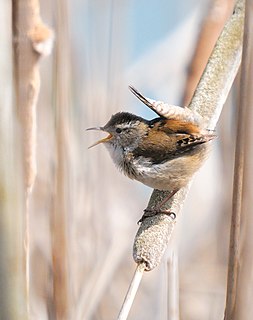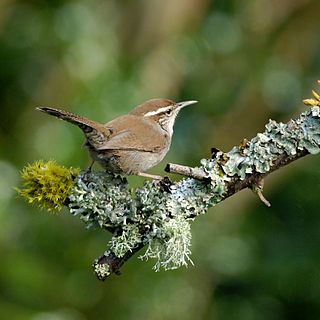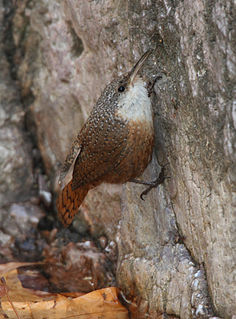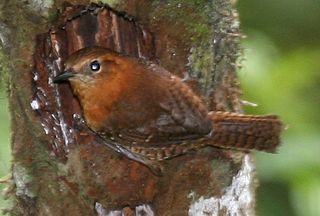
Wrens are a family of brown passerine birds in the predominantly New World family Troglodytidae. The family includes 88 species divided into 19 genera. Only the Eurasian wren occurs in the Old World, where, in Anglophone regions, it is commonly known simply as the "wren", as it is the originator of the name. The name wren has been applied to other, unrelated birds, particularly the New Zealand wrens (Acanthisittidae) and the Australian wrens (Maluridae).

The house wren is a very small songbird of the wren family, Troglodytidae. It occurs from Canada to southernmost South America, and is thus the most widely distributed native bird in the Americas. It occurs in most suburban areas in its range and it is the single most common wren. Its taxonomy is highly complex and some subspecies groups are often considered separate species. The name troglodytes means "hole dweller", and is a reference to bird's tendency to disappear into crevices when hunting insects or to seek shelter.

The Carolina wren is a common species of wren that is a resident in the eastern half of the United States of America, the extreme south of Ontario, Canada, and the extreme northeast of Mexico. Severe winters restrict the northern limits of their range while favorable weather conditions lead to a northward extension of their breeding range. Their preferred habitat is in dense cover in forest, farm edges and suburban areas. This wren is the state bird of South Carolina.

The Bewick's wren is a wren native to North America. At about 14 cm (5.5 in) long, it is grey-brown above, white below, with a long white eyebrow. While similar in appearance to the Carolina wren, it has a long tail that is tipped in white. The song is loud and melodious, much like the song of other wrens. It lives in thickets, brush piles and hedgerows, open woodlands and scrubby areas, often near streams. It eats insects and spiders, which it gleans from vegetation or finds on the ground.

The black-chinned sparrow is a small bird in the genus Spizella, in the New World sparrow family Passerellidae. It is found in the southwestern United States and throughout much of Mexico north of the Isthmus of Tehuantepec; most populations in the US migrate south after breeding while those in Mexico are resident. It is a slim, long-tailed bird, primarily gray with a reddish-brown back streaked with black, brown wings and tail, a pink beak, and brownish legs and feet. In the breeding season, the male shows black on his throat, chin, and the front of his face. Females, youngsters and nonbreeding males show little or no black in these areas. An unobtrusive bird, it spends much of its time foraging slowly along the ground, either alone or in small groups, sometimes mixing with other Spizella species. It is an omnivore, feeding primarily on seeds during the winter and insects during the summer. It builds a cup-shaped nest of grasses, rootlets, or plant fibers, into which the female lays 2–5 pale blue eggs. The female does most or all of the egg incubation, but both parents feed the hatched nestlings.

The rufous-crowned sparrow is a small American sparrow. This passerine is primarily found across the Southwestern United States and much of the interior of Mexico, south to the transverse mountain range, and to the Pacific coast to the southwest of the transverse range. Its distribution is patchy, with populations often being isolated from each other. Twelve subspecies are generally recognized, though up to eighteen have been suggested. This bird has a brown back with darker streaks and gray underparts. The crown is rufous, and the face and supercilium are gray with a brown or rufous streak extending from each eye and a thick black malar streak.

The canyon wren is a small North American songbird of the wren family Troglodytidae. It is resident throughout its range and is generally found in arid, rocky cliffs, outcrops, and canyons. It is a small bird that is hard to see on its rocky habitat; however, it can be heard throughout the canyons by its distinctive, loud song. It is currently in a monotypic taxon and is the only species in the genus Catherpes.

Troglodytes is a genus of small passerine birds in the wren family. These wrens are around 11–13 centimetres (4.3–5.1 in) long. They are brownish above and somewhat paler below, with strong legs. Their short rounded wings and frequently cocked tail have a dark barred pattern. The flight is direct and buzzing.

The ochraceous wren is a small songbird of the wren family. It is a resident breeding species in Costa Rica, Panama, and Colombia.

The chestnut-breasted wren is a species of bird in the family Troglodytidae. It is found in Colombia, Ecuador, Peru and Bolivia.

The blue mockingbird is a species of bird in the family Mimidae. It is endemic to Mexico, but has occurred as a vagrant in the southern United States. Its natural habitats are subtropical or tropical dry forests, subtropical or tropical moist montane forests, and heavily degraded former forest.

The Sinaloa wren is a species of bird in the family Troglodytidae. It is endemic to Mexico, with almost annual sightings in the United States, in Arizona.

The rufous-browed wren is a species of bird in the family Troglodytidae. It is found in Central America from Mexico south into Nicaragua.

The tepui wren is a species of bird in the family Troglodytidae. It is found in Brazil, Guyana, and Venezuela, where it inhabits high tablelands called tepuis.
The Socorro wren is a species of bird in the family Troglodytidae. It is endemic to Socorro Island, Mexico. It was formerly placed in Thryomanes but was moved to Troglodytes considering "manners, song, plumage, etc." and by biogeography and mtDNA NADH dehydrogenase subunit 2 sequence analysis.

Ergaticus was a genus of New World warblers — small passerine birds found only in the Americas. It was subsumed into Cardellina in 2011. The name is the Latinized version of the Ancient Greek ergatikos, meaning "willing or able to work". The genus contains two sister species: the red warbler, which is endemic to the Mexican highlands north of the Isthmus of Tehuantepec, and the pink-headed warbler, which is found south of the Isthmus, from the highlands of Chiapas, Mexico down into Guatemala. Though they are separated by geography and differ considerably in plumage, the two have sometimes been considered to be conspecific.

The Baja pygmy owl or cape pygmy owl, is a subspecies of northern pygmy owl restricted to the Mexican state of Baja California Sur. Although some taxonomists, including the International Ornithologists' Union, consider it to be a distinct species, other authorities, including the American Ornithological Society, do not consider it separate, and consider it to be a subspecies of the northern pygmy owl.

The cactus wren is a species of wren endemic to the deserts of the southwestern United States and northern and central Mexico. It is the state bird of Arizona, and the largest wren in the United States. Its plumage is brown, with black and white spots as markings. It has a distinctive white eyebrow that sweeps to the nape of the neck. The chest is white, whereas the underparts are cinnamon-buff colored. Both sexes appear similar. The tail, as well as flight feathers, are barred in black and white. Their song is a loud raspy chirrup; akin in the description of some ornithologists to the sound of a car engine that will not start. It is well-adapted to its native desert environment, and the birds can meet their water needs from their diet which consists chiefly of insects, but also of some plant matter. The cactus wren is a poor flier and generally forages for food on the ground. Ornithologists generally recognize seven subspecies, with the exact taxonomy under dispute.
The Shetland wren is a small passerine bird in the wren family. It is a subspecies of the Eurasian wren endemic to the Shetland archipelago of Scotland, with the exception of Fair Isle which has its own endemic subspecies, the Fair Isle wren. The Shetland wren is distinguished by its darker and more rufous-brown colouring from the mainland form, with a heavily barred underside, the barring extending from belly to breast. The bill is stouter and longer and it has stronger legs.

The Eurasian wren is a very small insectivorous bird, and the only member of the wren family Troglodytidae found in Eurasia and Africa (Maghreb). In Anglophone Europe, it is commonly known simply as the wren. It has a very short tail which is often held erect, a short neck and a relative long thin bill. It is russet brown above, paler buff-brown below and has a cream buff supercilium. The sexes are alike.


















